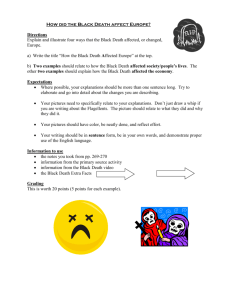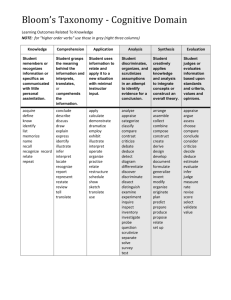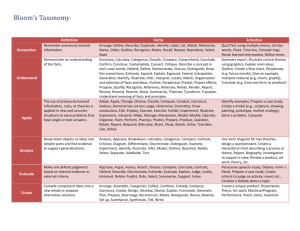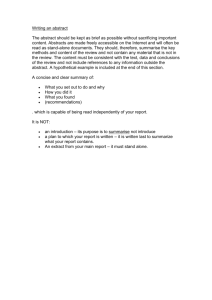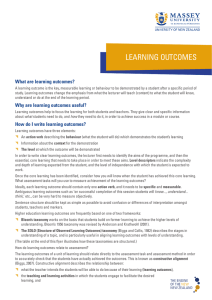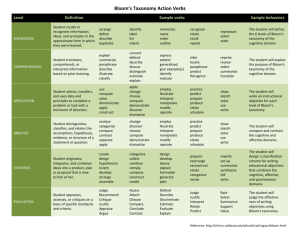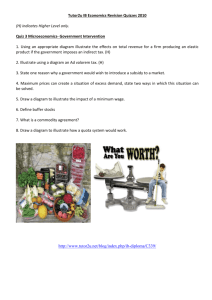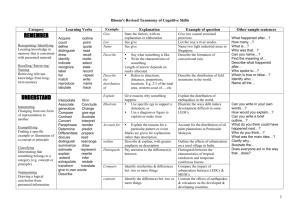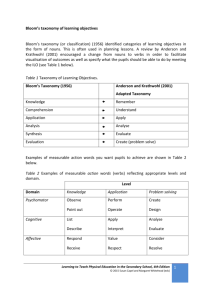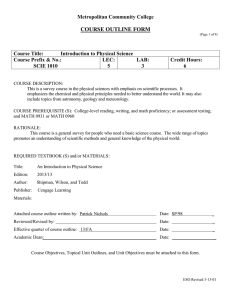Anderson and Krathwohl's (2000) revision of Bloom's
advertisement
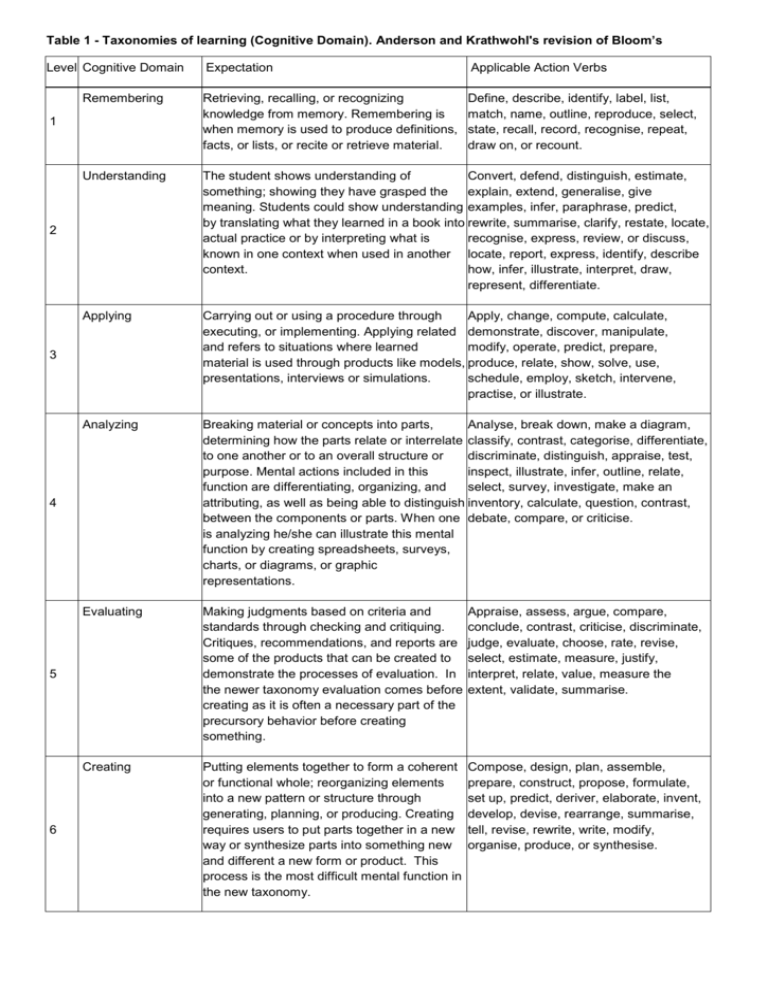
Table 1 - Taxonomies of learning (Cognitive Domain). Anderson and Krathwohl's revision of Bloom’s Level Cognitive Domain Expectation Applicable Action Verbs Remembering Retrieving, recalling, or recognizing knowledge from memory. Remembering is when memory is used to produce definitions, facts, or lists, or recite or retrieve material. Define, describe, identify, label, list, match, name, outline, reproduce, select, state, recall, record, recognise, repeat, draw on, or recount. Understanding The student shows understanding of Convert, defend, distinguish, estimate, something; showing they have grasped the explain, extend, generalise, give meaning. Students could show understanding examples, infer, paraphrase, predict, by translating what they learned in a book into rewrite, summarise, clarify, restate, locate, actual practice or by interpreting what is recognise, express, review, or discuss, known in one context when used in another locate, report, express, identify, describe context. how, infer, illustrate, interpret, draw, represent, differentiate. Applying Carrying out or using a procedure through Apply, change, compute, calculate, executing, or implementing. Applying related demonstrate, discover, manipulate, and refers to situations where learned modify, operate, predict, prepare, material is used through products like models, produce, relate, show, solve, use, presentations, interviews or simulations. schedule, employ, sketch, intervene, practise, or illustrate. Analyzing Breaking material or concepts into parts, Analyse, break down, make a diagram, determining how the parts relate or interrelate classify, contrast, categorise, differentiate, to one another or to an overall structure or discriminate, distinguish, appraise, test, purpose. Mental actions included in this inspect, illustrate, infer, outline, relate, function are differentiating, organizing, and select, survey, investigate, make an attributing, as well as being able to distinguish inventory, calculate, question, contrast, between the components or parts. When one debate, compare, or criticise. is analyzing he/she can illustrate this mental function by creating spreadsheets, surveys, charts, or diagrams, or graphic representations. Evaluating Making judgments based on criteria and standards through checking and critiquing. Critiques, recommendations, and reports are some of the products that can be created to demonstrate the processes of evaluation. In the newer taxonomy evaluation comes before creating as it is often a necessary part of the precursory behavior before creating something. Appraise, assess, argue, compare, conclude, contrast, criticise, discriminate, judge, evaluate, choose, rate, revise, select, estimate, measure, justify, interpret, relate, value, measure the extent, validate, summarise. Creating Putting elements together to form a coherent or functional whole; reorganizing elements into a new pattern or structure through generating, planning, or producing. Creating requires users to put parts together in a new way or synthesize parts into something new and different a new form or product. This process is the most difficult mental function in the new taxonomy. Compose, design, plan, assemble, prepare, construct, propose, formulate, set up, predict, deriver, elaborate, invent, develop, devise, rearrange, summarise, tell, revise, rewrite, write, modify, organise, produce, or synthesise. 1 2 3 4 5 6 Evaluating Learning Outcomes for EQAL 1. Are there an appropriate number of LOs? (5 or less) 2. Do the LOs contain any ambiguous terminology (e.g understand(ing), awareness? 3. Can you identify the action verb and the level of Bloom’s taxonomy for each LO? Is the level appropriate? 4. Can you determine the context of the learning for each LO? 5. Do the learning outcomes make it clear to the student what they will be able to DO on completion of the unit? 6. Can you map each LO to one or more of the MMU graduate outcomes? 7. Is it possible to measure/assess the learning outcomes in 2 summative pieces of work? 8. Are the LOs fit for purpose based on 1-7?

